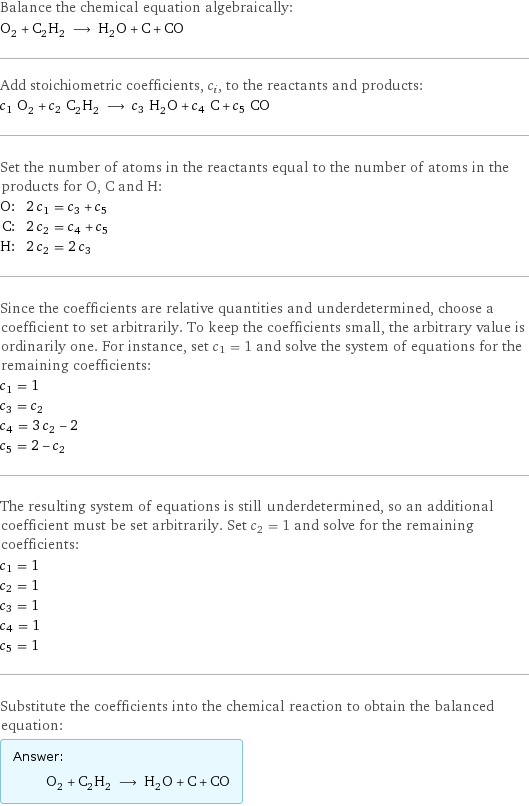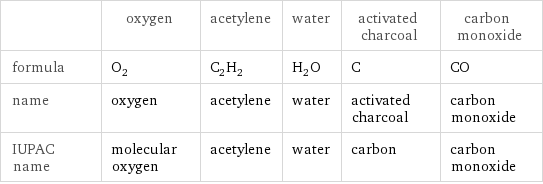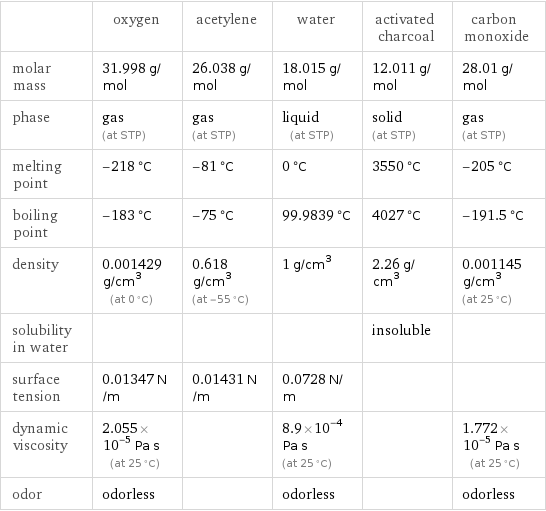Input interpretation

O_2 oxygen + C_2H_2 acetylene ⟶ H_2O water + C activated charcoal + CO carbon monoxide
Balanced equation

Balance the chemical equation algebraically: O_2 + C_2H_2 ⟶ H_2O + C + CO Add stoichiometric coefficients, c_i, to the reactants and products: c_1 O_2 + c_2 C_2H_2 ⟶ c_3 H_2O + c_4 C + c_5 CO Set the number of atoms in the reactants equal to the number of atoms in the products for O, C and H: O: | 2 c_1 = c_3 + c_5 C: | 2 c_2 = c_4 + c_5 H: | 2 c_2 = 2 c_3 Since the coefficients are relative quantities and underdetermined, choose a coefficient to set arbitrarily. To keep the coefficients small, the arbitrary value is ordinarily one. For instance, set c_1 = 1 and solve the system of equations for the remaining coefficients: c_1 = 1 c_3 = c_2 c_4 = 3 c_2 - 2 c_5 = 2 - c_2 The resulting system of equations is still underdetermined, so an additional coefficient must be set arbitrarily. Set c_2 = 1 and solve for the remaining coefficients: c_1 = 1 c_2 = 1 c_3 = 1 c_4 = 1 c_5 = 1 Substitute the coefficients into the chemical reaction to obtain the balanced equation: Answer: | | O_2 + C_2H_2 ⟶ H_2O + C + CO
Structures

+ ⟶ + +
Names

oxygen + acetylene ⟶ water + activated charcoal + carbon monoxide
Equilibrium constant
![Construct the equilibrium constant, K, expression for: O_2 + C_2H_2 ⟶ H_2O + C + CO Plan: • Balance the chemical equation. • Determine the stoichiometric numbers. • Assemble the activity expression for each chemical species. • Use the activity expressions to build the equilibrium constant expression. Write the balanced chemical equation: O_2 + C_2H_2 ⟶ H_2O + C + CO Assign stoichiometric numbers, ν_i, using the stoichiometric coefficients, c_i, from the balanced chemical equation in the following manner: ν_i = -c_i for reactants and ν_i = c_i for products: chemical species | c_i | ν_i O_2 | 1 | -1 C_2H_2 | 1 | -1 H_2O | 1 | 1 C | 1 | 1 CO | 1 | 1 Assemble the activity expressions accounting for the state of matter and ν_i: chemical species | c_i | ν_i | activity expression O_2 | 1 | -1 | ([O2])^(-1) C_2H_2 | 1 | -1 | ([C2H2])^(-1) H_2O | 1 | 1 | [H2O] C | 1 | 1 | [C] CO | 1 | 1 | [CO] The equilibrium constant symbol in the concentration basis is: K_c Mulitply the activity expressions to arrive at the K_c expression: Answer: | | K_c = ([O2])^(-1) ([C2H2])^(-1) [H2O] [C] [CO] = ([H2O] [C] [CO])/([O2] [C2H2])](../image_source/b35bc9c84bbb7f6f2a79d434be53eb88.png)
Construct the equilibrium constant, K, expression for: O_2 + C_2H_2 ⟶ H_2O + C + CO Plan: • Balance the chemical equation. • Determine the stoichiometric numbers. • Assemble the activity expression for each chemical species. • Use the activity expressions to build the equilibrium constant expression. Write the balanced chemical equation: O_2 + C_2H_2 ⟶ H_2O + C + CO Assign stoichiometric numbers, ν_i, using the stoichiometric coefficients, c_i, from the balanced chemical equation in the following manner: ν_i = -c_i for reactants and ν_i = c_i for products: chemical species | c_i | ν_i O_2 | 1 | -1 C_2H_2 | 1 | -1 H_2O | 1 | 1 C | 1 | 1 CO | 1 | 1 Assemble the activity expressions accounting for the state of matter and ν_i: chemical species | c_i | ν_i | activity expression O_2 | 1 | -1 | ([O2])^(-1) C_2H_2 | 1 | -1 | ([C2H2])^(-1) H_2O | 1 | 1 | [H2O] C | 1 | 1 | [C] CO | 1 | 1 | [CO] The equilibrium constant symbol in the concentration basis is: K_c Mulitply the activity expressions to arrive at the K_c expression: Answer: | | K_c = ([O2])^(-1) ([C2H2])^(-1) [H2O] [C] [CO] = ([H2O] [C] [CO])/([O2] [C2H2])
Rate of reaction
![Construct the rate of reaction expression for: O_2 + C_2H_2 ⟶ H_2O + C + CO Plan: • Balance the chemical equation. • Determine the stoichiometric numbers. • Assemble the rate term for each chemical species. • Write the rate of reaction expression. Write the balanced chemical equation: O_2 + C_2H_2 ⟶ H_2O + C + CO Assign stoichiometric numbers, ν_i, using the stoichiometric coefficients, c_i, from the balanced chemical equation in the following manner: ν_i = -c_i for reactants and ν_i = c_i for products: chemical species | c_i | ν_i O_2 | 1 | -1 C_2H_2 | 1 | -1 H_2O | 1 | 1 C | 1 | 1 CO | 1 | 1 The rate term for each chemical species, B_i, is 1/ν_i(Δ[B_i])/(Δt) where [B_i] is the amount concentration and t is time: chemical species | c_i | ν_i | rate term O_2 | 1 | -1 | -(Δ[O2])/(Δt) C_2H_2 | 1 | -1 | -(Δ[C2H2])/(Δt) H_2O | 1 | 1 | (Δ[H2O])/(Δt) C | 1 | 1 | (Δ[C])/(Δt) CO | 1 | 1 | (Δ[CO])/(Δt) (for infinitesimal rate of change, replace Δ with d) Set the rate terms equal to each other to arrive at the rate expression: Answer: | | rate = -(Δ[O2])/(Δt) = -(Δ[C2H2])/(Δt) = (Δ[H2O])/(Δt) = (Δ[C])/(Δt) = (Δ[CO])/(Δt) (assuming constant volume and no accumulation of intermediates or side products)](../image_source/6fea5029ea2425b1f94ab7dba1781568.png)
Construct the rate of reaction expression for: O_2 + C_2H_2 ⟶ H_2O + C + CO Plan: • Balance the chemical equation. • Determine the stoichiometric numbers. • Assemble the rate term for each chemical species. • Write the rate of reaction expression. Write the balanced chemical equation: O_2 + C_2H_2 ⟶ H_2O + C + CO Assign stoichiometric numbers, ν_i, using the stoichiometric coefficients, c_i, from the balanced chemical equation in the following manner: ν_i = -c_i for reactants and ν_i = c_i for products: chemical species | c_i | ν_i O_2 | 1 | -1 C_2H_2 | 1 | -1 H_2O | 1 | 1 C | 1 | 1 CO | 1 | 1 The rate term for each chemical species, B_i, is 1/ν_i(Δ[B_i])/(Δt) where [B_i] is the amount concentration and t is time: chemical species | c_i | ν_i | rate term O_2 | 1 | -1 | -(Δ[O2])/(Δt) C_2H_2 | 1 | -1 | -(Δ[C2H2])/(Δt) H_2O | 1 | 1 | (Δ[H2O])/(Δt) C | 1 | 1 | (Δ[C])/(Δt) CO | 1 | 1 | (Δ[CO])/(Δt) (for infinitesimal rate of change, replace Δ with d) Set the rate terms equal to each other to arrive at the rate expression: Answer: | | rate = -(Δ[O2])/(Δt) = -(Δ[C2H2])/(Δt) = (Δ[H2O])/(Δt) = (Δ[C])/(Δt) = (Δ[CO])/(Δt) (assuming constant volume and no accumulation of intermediates or side products)
Chemical names and formulas

| oxygen | acetylene | water | activated charcoal | carbon monoxide formula | O_2 | C_2H_2 | H_2O | C | CO name | oxygen | acetylene | water | activated charcoal | carbon monoxide IUPAC name | molecular oxygen | acetylene | water | carbon | carbon monoxide
Substance properties

| oxygen | acetylene | water | activated charcoal | carbon monoxide molar mass | 31.998 g/mol | 26.038 g/mol | 18.015 g/mol | 12.011 g/mol | 28.01 g/mol phase | gas (at STP) | gas (at STP) | liquid (at STP) | solid (at STP) | gas (at STP) melting point | -218 °C | -81 °C | 0 °C | 3550 °C | -205 °C boiling point | -183 °C | -75 °C | 99.9839 °C | 4027 °C | -191.5 °C density | 0.001429 g/cm^3 (at 0 °C) | 0.618 g/cm^3 (at -55 °C) | 1 g/cm^3 | 2.26 g/cm^3 | 0.001145 g/cm^3 (at 25 °C) solubility in water | | | | insoluble | surface tension | 0.01347 N/m | 0.01431 N/m | 0.0728 N/m | | dynamic viscosity | 2.055×10^-5 Pa s (at 25 °C) | | 8.9×10^-4 Pa s (at 25 °C) | | 1.772×10^-5 Pa s (at 25 °C) odor | odorless | | odorless | | odorless
Units
